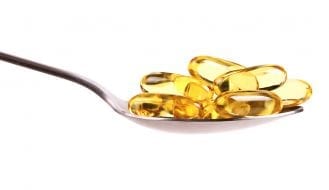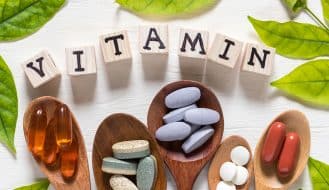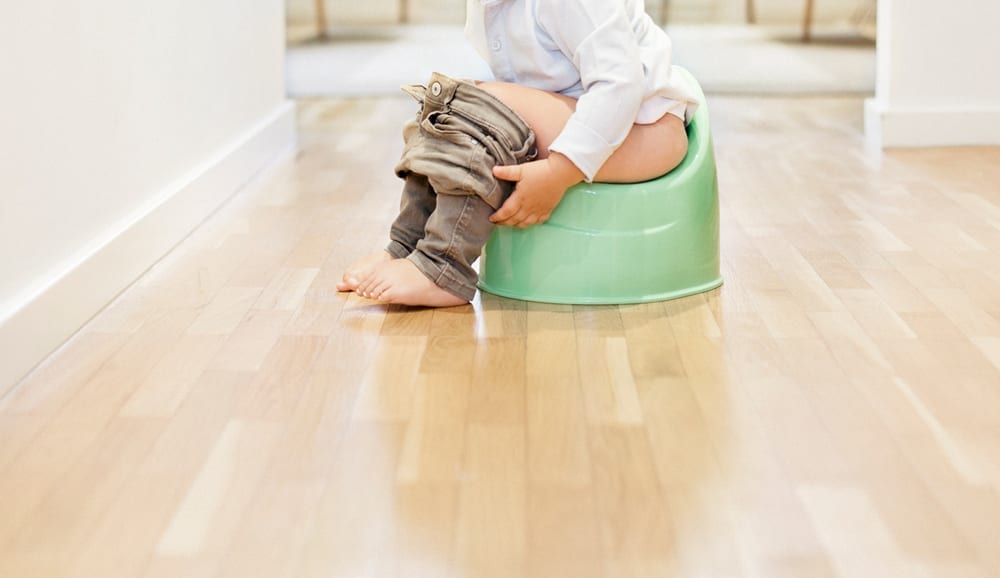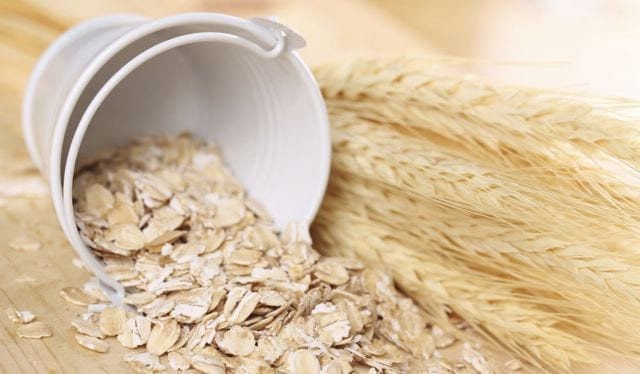Fish Oil and Fiber: How to be Number One at ‘Number Two’
Countless blogs detail how exercising, eating well, sleeping better, and having strong social networks are crucial for healthy aging. But there’s one aspect to good health that people rarely mention: pooping.
Yes, pooping.
Maybe as a physician, I should be medically correct and write “defecating” instead. But whatever the term, one thing is certain: A regular bowel movement is essential for feeling good.
Chronically Constipated? It Could Be a Symptom of Intestinal Dysbiosis
A proper poop is dependent on a healthy gut. And if you regularly struggle with constipation or diarrhea (as well as other symptoms, like indigestion, reflux, bloating, or excessive gas), it could be a sign that you gut is not functioning optimally.
In medicine, we use the term intestinal dysbiosis, which means that the populations of the different gut bacteria that colonize the stomach have become imbalanced. Today, we know that these gut bacteria dictate a huge range of not just bowel-related disorders — like Irritable Bowel Syndrome (IBS) and chronic constipation — but also our weight, blood sugar levels and immune response to a wide range of chronic diseases (1, 2).
The composition of our gut flora depends on a variety of factors, including genetics, age, and environment. Diet, however, plays an especially big role.
Let’s focus on two stool-facilitating nutrients that play a critical role in promoting good intestinal health: fiber and fish oil.
The Digestive Benefits of Fibers
Almost every constipation-related article talks about the importance of eating enough fiber — and with good reason. Fiber has a profound impact on our digestive system.
First and foremost, fiber promotes good microbial health. Gut bacteria feed on fiber through fermentation, breaking them down in the digestive system. During this fermentation process, the bacteria create short-chained fatty acids (SCFAs) that help support the integrity of the cells in the stomach. SCFAs also influence our metabolism, appetite, and immune response (3).
Oats are an excellent source of beta-glucan soluble fibers.
How Soluble and Insoluble Fiber Function
As I explain in Carbo-Confusion Unraveled, the term “fiber” encompasses a number of carbohydrates, and different types of fiber impact our digestive system in unique ways. For instance, beta-glucan soluble fibers (found in oats and barley) are easily fermented by the gut bacteria (3). Beta-glucan fiber is also known to bind together with cholesterol, thereby helping to remove it from the body (4).
Insoluble fibers, on the other hand, are generally not fermented by the gut bacteria. Still, insoluble fiber (which can be found in foods like wheat bran) is important since it helps push food through the intestinal tract. Certain types of insoluble fiber, like psyllium, also bind together with water, to help soften the stool. Both of these elements have a natural laxative effect (5).
Why Fiber-Rich Foods Are So Important
Because different types of fibers produce a varied effect on our digestive system and feed different bacteria species, eating a variety is best for promoting microbial health.
Unfortunately, thanks to the large quantities of processed foods favored in the Western diet, most of us don’t get enough fiber. While studies show massive improvements in microbial diversity when people consume more than 30 grams of fiber daily, most Americans only get between 12-18 grams on average (3).
With these kinds of numbers, it’s not surprising that rates of intestinal dysbiosis and related diseases (e.g. irritable bowel syndrome) are on the rise (6).
The Benefits of Omega-3 Fish Oil for Constipation
Since oils act as natural lubricants, most varieties will help get the “ball rolling” in the restroom. For better bowel movements, however, omega-3 fish oils have clear advantages to other types.
Intestinal Alkaline Phosphatase
Firstly, fish oil is known to increase the production of intestinal alkaline phosphatase (IAP) (7). IAP plays a crucial role in maintaining gut homeostasis and reducing inflammation in the intestines. Researchers have also found a link between reduced IAP concentrations and conditions like IBS (8).
Antimicrobial Properties
Secondly, full-spectrum fish oil has antimicrobial properties that help keep certain endotoxin-producing bacteria species from wreaking havoc in the gut (7). Since endotoxins cause inflammation, blocking their build-up helps to reduce inflammation in the intestines.
Healthier Gut Flora
Finally, fish oil also promotes a better composition of gut bacteria. For instance, in clinical studies of individuals with IBS, the researchers found that omega-3 supplementation increased the population of certain healthy bacterial species. What’s more, it decreased the levels of other harmful bacterial groups, resulting in a healthier microbiome (7).

Taking a fresh omega-3 fish oil is a good way to support the microbiome.
Can Fish Oil Cause Diarrhea?
If omega-3 fatty acids can help with constipation, can fish oil be too effective and cause diarrhea? Be aware that consuming large quantities of fish oil, or taking a poor-quality fish oil supplement, can sometimes contribute to unpleasant gastrointestinal issues and loose stools.
That being said, a number of studies show that fish oil supplementation can also reduce the incidence of diarrhea (9). For instance, one study feeding hospitalized patients a combination of fish oil and fiber found significantly lower rates of diarrhea in the omega-3 and fiber group compared to the control (10).
Other Tips for Producing Healthy Poops
Besides consuming more omega-3 fish oil and fiber, there are also other tactics that you can use to promote good gut health and keep the intestinal system moving.
1. Cut Out Unnecessary Antibiotics
Antibiotics not only kill off harmful gut bacteria, but also health-promoting bacterial populations in your gut for years to come. This is why antibiotic use is often linked with both constipation and diarrhea.
2. Avoid Processed Foods
Processed foods are typically devoid of fibers and omega-3s, as well as rich in refined sugars and unhealthy fats. These kinds of foods promote intestinal dysbiosis by stimulating the growth of harmful bacterial populations and inflammation.
3. Get Regular Exercise
Exercise helps to stimulate peristaltic contractions. These wavelike, squeezing contractions help push the fecal mass through the colon. Plus, exercising regularly seems to have a beneficial impact on the microbiome too (11).
4. Drink Enough Water
Since water helps keep bowel movements soft and easy to pass, continue to sip water throughout the day.
Staying hydrated is an affordable way to make life a little easier on the toilet.
5. Pay Attention to Your Stool Signals
One of the most important aspects of defecating has nothing to do with lifestyle or nutrition.
It has to do with listening to the ‘signal’ that tells you to leave everything you’re doing and head for the nearest toilet.
Like everything in life that’s worth doing, you have to make time for bathroom breaks and respect your body’s needs. While it might not be convenient, simply take a break and go to the restroom when you feel an urge. If you continuously ignore the signal, your body — like a jilted lover — closes down the communication channel and says, “Sorry. You don’t listen, so why should I make the effort to talk to you?” In other words, you shut down the nerve reflex that facilitates pooping, increasing the tendency for future constipation.
What Should My Poop Look Like?
As a physician, I was always amazed when I questioned patients about their defecations and they responded by saying: “I don’t know — I don’t look at my stools.”
Now maybe I am too anal, but the examination of a stool can reveal a lot about what is going on inside of a person. Being able to give your physician a description of the color, consistency, and frequency of bowel movements can be helpful in providing a diagnosis. So always be sure to take a peek before flushing away a wealth of information.
The Bristol stool chart gives an overview over various stool consistencies and an assessment of what is considered normal. Plus, you get to see what constipation versus diarrhea looks like.
There are also charts that provide an overview over various stool colors. Normally, stools are light to dark brown in color. If your stools are black, yellow or white, you may need to seek medical help. Streaks of red on the outside of your stool usually indicate that you have hemorrhoids in the lower digestive tract, but a physician should be able to help you diagnose the issue.
How Often Should I Be Pooping?
If you take fish oil, enjoy a high fiber diet, drink lots of liquids, and exercise regularly, chances are that you’ve mastered the art of producing a proper bowel movement. Still, what does it mean to be ‘regular’?
While most people defecate once a day, the so-called ‘normal’ interval between defecations varies greatly. Constipation is defined as having fewer than three bowel movements every seven days. Some people are able to produce two to three stools a day, which is still considered within the normal range.
Given such a wide definition for ‘regularity,’ the most important thing to remember is that consistency is key.
Support Your Gut with Omega Cookie®
At Omega3 Innovations, we’re passionate about the combined benefits of fresh fish oil and fiber, which is a safe, natural constipation remedy for everyone! We also care deeply about making these nutrients more accessible through high quality, great-tasting foods.
Whether you use our Omega Cure® fish oil with an otherwise high-fiber diet of your own making – or shake things up with a delicious high-fiber omega-3 cookie – you’ll be making a positive difference for your gut in a multitude of ways.
An Effective Omega-3 Dose, Made Simple
Experience the Omega3 Innovations difference for yourself with the most effective fish oil supplement on the market.
Buy Now
References:
1. Cao, H. et al. (2017). Dysbiosis Contributes to Chronic Constipation Development Via Regulation of Serotonin Transporter in the Intestine. Scientific Reports, 7(1), 10322.
2. Gobert, A. P. et al. (2016). The Human Intestinal Microbiota of Constipated-Predominant Irritable Bowel Syndrome Patients Exhibits Anti-Inflammatory Properties. Scientific Reports, 6, 39399.
3. Holscher H. D. (2017). Dietary Fiber and Prebiotics and the Gastrointestinal Microbiota. Gut Microbes, 8(2), 172–184.
4. Sima, P., Vannucci, L., & Vetvicka, V. (2018). β-Glucans and Cholesterol (Review). International Journal of Molecular Medicine, 41(4), 1799–1808.
5. McRorie, J.W. & McKeown, N,M. (2017). Understanding the Physics of Functional Fibers in the Gastrointestinal Tract: An Evidence-Based Approach to Resolving Enduring Misconceptions about Insoluble and Soluble Fiber. Journal of the Academy of Nutrition and Dietetics, 117(2):251-264.
6. Parolini C. (2019). Effects of Fish n-3 PUFAs on Intestinal Microbiota and Immune System. Marine Drugs, 17(6), 374.
7. Costantini, L., Molinari, R., Farinon, B., & Merendino, N. (2017). Impact of Omega-3 Fatty Acids on the Gut Microbiota. International Journal of Molecular Sciences, 18(12), 2645.
8. Bilski, J. et al. (2017). The Role of Intestinal Alkaline Phosphatase in Inflammatory Disorders of Gastrointestinal Tract. Mediators of Inflammation, 2017, 9074601.
9. Sharma, M., Kaur, R., Kaushik, K., & Kaushal, N. (2019). Redox Modulatory Protective Effects of ω-3 Fatty Acids Rich Fish Oil Against Experimental Colitis. Toxicology, Mechanisms, & Methods, 29(4): 244-254.
10. Jakobsen, L.H., Wirth, R., Smoliner, C., Klebach, M., Hofman, Z., & Kondrup, J. (2017). Gastrointestinal Tolerance and Plasma Status of Carotenoids, EPA and DHA with a Fiber-Enriched Tube Feed in Hospitalized Patients Initiated on Tube Nutrition: Randomized Controlled Trial. Clinical Nutrition, 36(2):380-388.
11. Cook, M. D. (2016). Exercise and Gut Immune Function: Evidence of Alterations in Colon Immune Cell Homeostasis and Microbiome Characteristics with Exercise Training. Immunology and Cell Biology, 94(2):158-63.
Popular posts



Related posts









